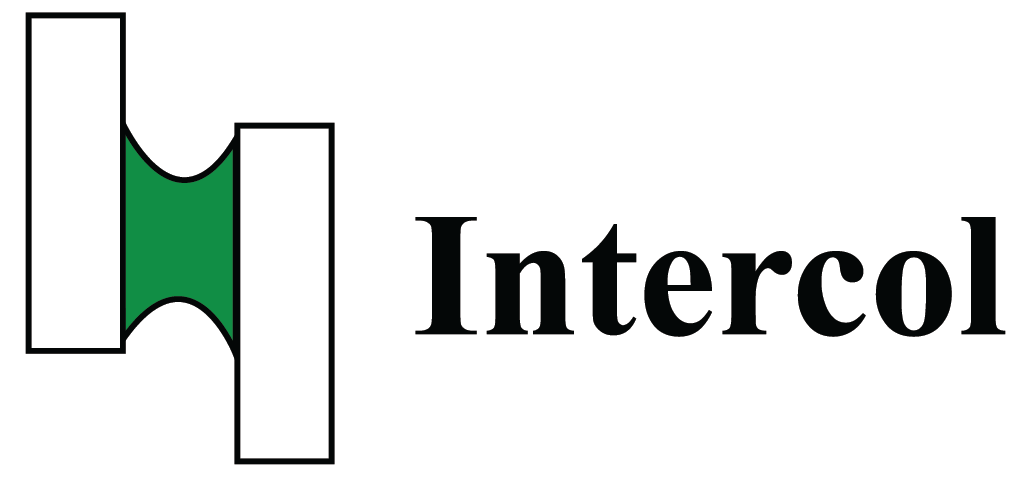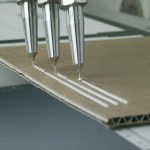Water-based adhesives are actually used everywhere, such as in the packaging industry, woodworking, cardboard processing, lamination, panel building, utility construction, bookbinding, the printing industry and so on. At many factories adhesives are used in the process, often this is a hot melt or a water based adhesive. There are many different types of adhesives, yet water based adhesives and hot melt are often used in industrial production processes because of their high efficiency and low cost. Most adhesives are developed for specific machine applications, depending on the production method or product requirements. Hot melt adhesives are in many processes easy to use with standard machines, short pressing times or longer machine downtimes are no problem for these adhesives. While water based adhesives are more cost efficient and can provide stronger joints, sometimes the advantage is that a water based adhesive does not add volume to, for example, flat stacked boxes.
Different Waterborne Adhesives
There are different water based adhesives, depending on application, product, or industry there are many variations possible. Water-based adhesives are also widely used in manual applications, such as wallpaper, floor and construction applications.
What is a Waterborne Adhesive?
Basically, adhesives must be liquid before they are applied. Traditionally, starch has been dissolved in water. Later, volatile solvents were used to speed up this process. Hotmelts become liquid by heating them. Glues usually have to be liquid to be able to wet a surface well, it usually has to flow out well to get optimally close to the surface in order to be able to exert vanderwaal forces. The purpose of the water is therefore to create a good flow and distribution, and after application this “solvent” must disappear in order to achieve a final final strength. Most waterborne adhesives are originally synthetic; based on polymers such as PVOH, EVA, and PVAC. There are also vegetable sources such as starch and sugar. Gelatin is also a waterborne type of hot melt. The right solution is often in the mix of parameters for application, production method and end product.
How Does Water Disappear?
In almost all waterborne adhesives the water evaporates through surfaces, in cement-bound adhesives the added water is part of the reaction to the end product, the water becomes part of the chemical composition of the cement. This is almost never the case with ready-to-use water-based adhesives. With water-based adhesives it is therefore important that at least one of the substrates is sufficiently porous to absorb the water or to allow it to evaporate.
How is a WaterBased Adhesive Made?
Intercol uses all kinds of raw materials from the industry, there are chemical suppliers of water based synthetic dispersions, which are delivered in liquid form. Many starches, PVOH and other binders and additives are delivered dry and have to be mixed in a specific way and conditions.
Is a WaterBased Adhesive Water Resistant?
Water-based adhesives can be water-soluble after drying, but can also be very waterproof. For example, mouth valve adhesives for envelopes are pre-eminently “reactivable” or remoistable, while D4 wood based PVAC adhesives can withstand boiling water after sufficient drying. The basis of the adhesive, VAE, EVA, PVAC, PVOH, casein, dextrin or starch, together with the additives such as crosslinkers, determines the final water resistance.
There are also “ice-water resistant” adhesives, these are specifically adhesives for the labelling of
Is A Waterborne Glue Perishable?
Waterborne adhesives are susceptible to spoilage differently for each adhesive. With synthetic adhesives, after a long time the packaging, that part that contains moist air and no glue, can become infected by moulds. The synthetic adhesive will generally not be affected. In the case of glues based on starch, casein or dextrin, the glue itself can really spoil.
Depending on the product and the permitted preservation, we guarantee a shelf life of the packaging provided it remains closed.
What Different Types of Waterborne Adhesives Are There?
Most waterborne adhesives today are synthetic; traditionally, vegetable-based vegetable-based adhesives are still made. Now environmental aspects, recycling, biodegradable and biobased in them, vegetable based adhesives get more attention.
What Types of Synthetic Adhesives Are There?
These are the most commonly used water based synthetic adhesives:
- PVAC Homopolymers
- Vinyl Acetate Copolymers
- Vinyl Acetate Copolymers
- Styrene / Acrylic Copolymers
- Acrylic Copolymers
- Terpolymers
What Types of Vegetable Glue Are available?
These are the most commonly used water-based vegetable adhesives:
- Potato Starch
- Recycled starch (waste products from agro industry)
- Wheat starch
- Cornstarch
- Methyl cellulose adhesive (wallpaper paste)
- Casein (milk protein)
- Dextrin
- Glucose, Sugar
In addition, other environmentally friendly adhesives are conceivable such as gelatin, protein adhesives, collagen adhesives, gum resin or latex from the rubber tree. These adhesives are not always pure vegetable or compostable.
Special Properties of a Number of These Vegetable And Environmentally Friendly Adhesives
Not all vegetable raw materials are suitable for making industrially applicable adhesives, this strongly depends on the specific application.
Starch and Dextrin adhesives
Starch and dextrin adhesives are known types of vegetable glues, these are already widely used for applications such as
- wallpaper paste, wall coverings
- paper production, corrugated board, pulp board, paper glue
- artisanal bookbinding
- labelling of cardboard, paper and glass, and all-round labelling on labelling machines
Starch adhesives are generally almost entirely biobased, biodegradable and compostable. They are probably the most inconvenient environmentally friendly adhesives. By applying food-safe additives, Intercol can further formulate this promising raw material to best meet the machine properties.
Casein Adhesives
Casein glues are based on animal protein that is mainly extracted from cow’s milk. In terms of raw material, it competes to a large extent with protein as used in whey products. Casein adhesives are still used in whey products:
- Glass labeling; preservatives, soft drinks, & beer
- The production of shoes
- Manual Cardboard and Paper Applications
Important properties of Casein adhesives are its high tack (viscosity) and stiff viscosity curve. In addition, these adhesives can be set fairly easily to waterproof, which is sometimes a requirement for labelling beer bottles. On the other hand, casein adhesives can dissolve well in water baths when reusing returnable bottles.
Special Properties of a Number of Waterborne Synthetic Adhesives
Waterborne synthetic adhesives range from water-thin liquid form to pastes and sealants. In particular, water-thin to paste-shaped products are widely used industrially. In industrial automated applications, many sealants can be faded by an assembly hot melt.
PVAC Adhesives
PVAC adhesives are the better known, and one of the oldest types of synthetic adhesives. This raw material mainly serves wood applications, cardboard and paper applications. Many D2, and D3 wood adhesives are examples of a pure PVAC adhesive. By formulating with this raw material, the adhesion can be improved and the water solubility can be improved or the water resistance can be set higher.
Copolymer Vinyl Acetate Adhesives
This copolymer adhesive can be seen as a modern, improved PVAC ljim. In addition to polyvinyl acetate (PVA), ethylene vinyl acetate (EVA) is used for the production of these dispersions. The waterborne mixture is white in itself, after application and drying of the adhesive a clear, flexible joint is formed which is also suitable for all kinds of applications such as paper, wood and plastic. Copolymer adhesives are widely used for the production of packaging, such as for use in the food industry.
Acrylic dispersion adhesives
Acrylates are used for specific markets and can sometimes serve as adhesion improvers in formulated ljimen. The standard dispersion acrylics dry as a normal waterborne adhesive. However, there are also many other acrylate based adhesives.
Acrylic dispersions are usually relatively environmentally friendly adhesive systems. Typical applications with acrylics:
- Production of self-adhesive materials such as tape and self-adhesive film
- Adhesion of foam materials
- As an adhesive for plastic materials and to adhere some types of rubber




